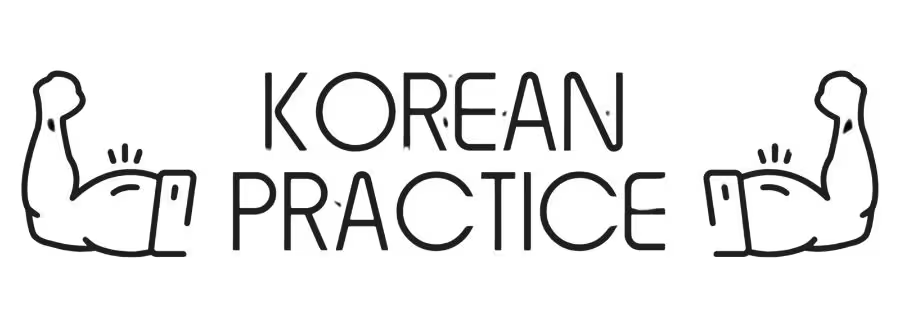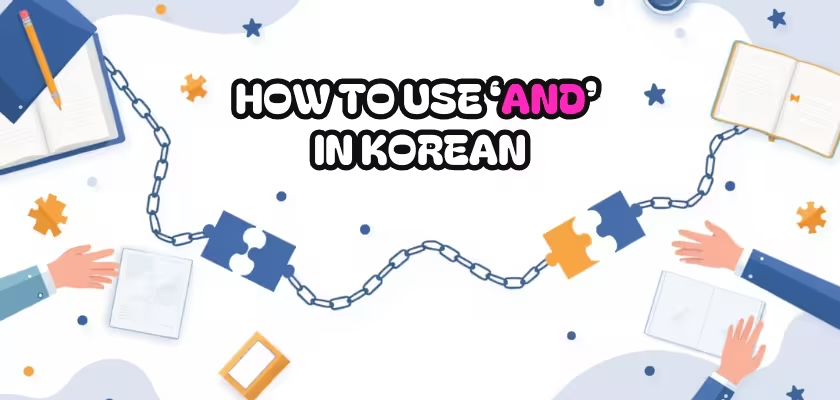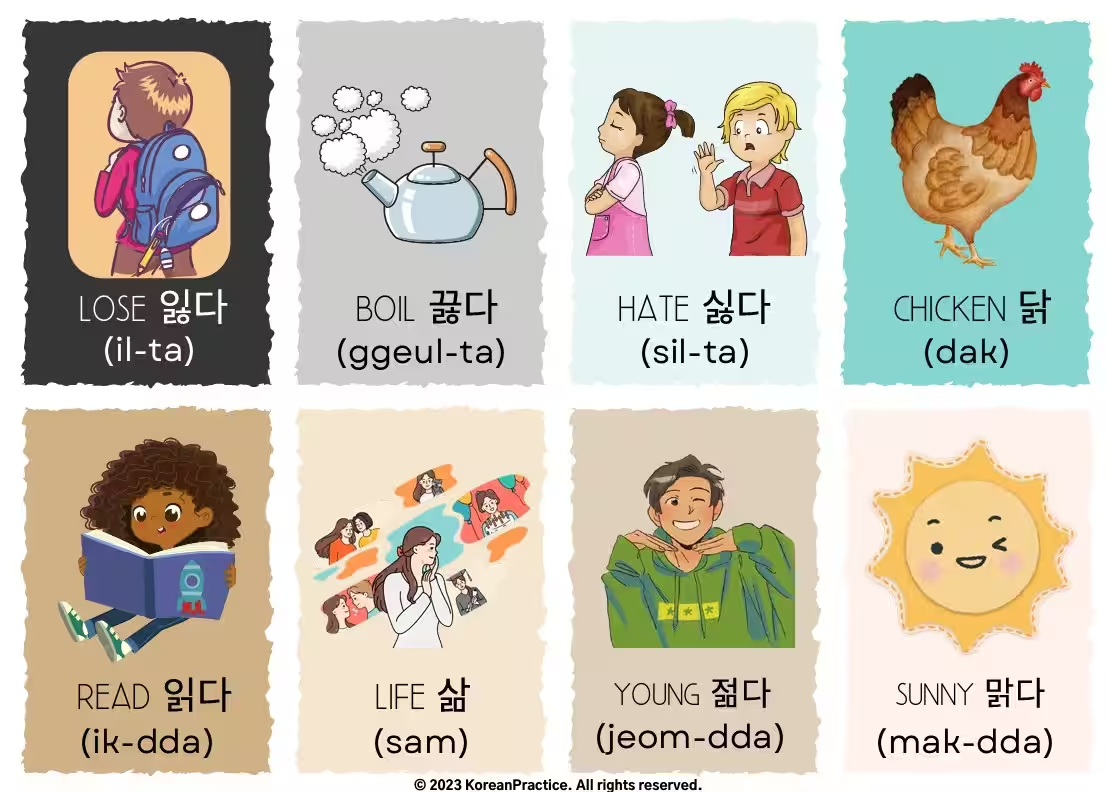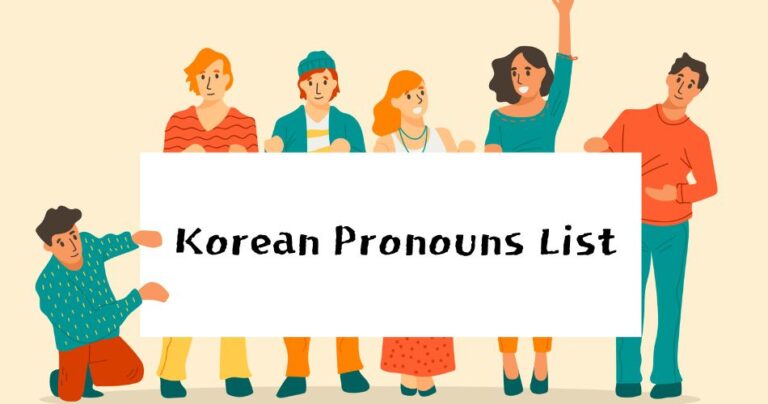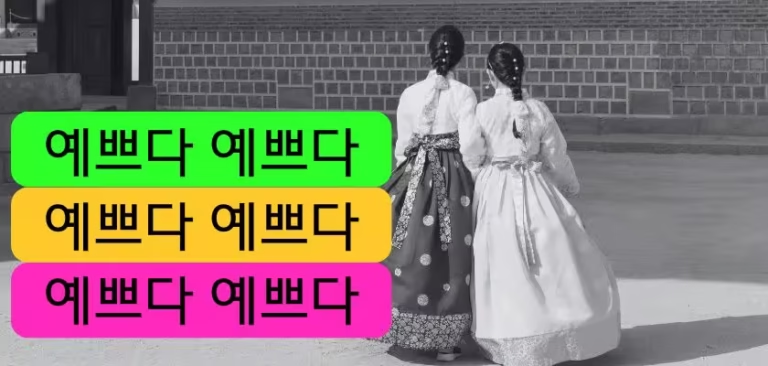Table of Contents
Introduction
Learning Korean can be super fun, but sometimes the little words can be the trickiest! Today we’re going to talk about how to say “and in Korean”. It might seem simple, but there are actually different ways to use “and” depending on what you’re trying to say. Don’t worry though – I’ll explain everything step by step!
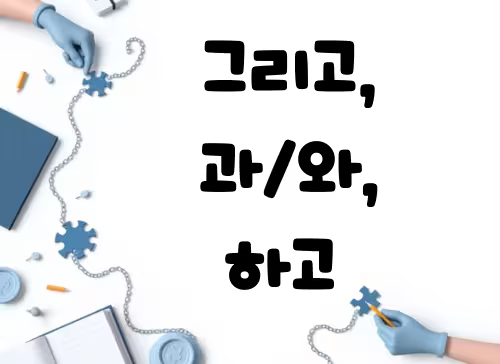
What Does “And” Mean in Korean Grammar?
In Korean grammar, “and” works a bit differently than in English. While English use just one word “and” for almost everything, Korean has several ways to connect words and sentences. The most common ones are 그리고 (geurigo), 와/과 (wa/gwa), and 하고 (hago). Each one is used in different situations, kind of like how English speaker might say “plus” or “also” in English sometimes instead of “and.”
Example: 저는 사과와 바나나를 좋아해요.
English Translation: I like apples and bananas.
Example: 오늘은 숙제를 했어요. 그리고 친구와 놀았어요.
English Translation: Today I did homework. And I played with my friend.
Example Sentences:
Original Korean Sentence
저는 사과와 바나나를 좋아해요.
Pronunciation Guide
저는 (jeo-neun) 사과와 (sa-gwa-wa) 바나나를 (ba-na-na-reul) 좋아해요 (jo-a-hae-yo).
Meaning and Context
저 (I; in a humble form) 는 (topic marker) 사과 (apple) 와 (and) 바나나 (banana) 를 (object marker) 좋아해요 (like; polite form).
English Translation
I like apples and bananas.
Literal Translation
I like apple and banana.
How to Use “And in Korean” Hangul
Let’s look at the different ways to write “and in Korean” hangul. The most basic form is 그리고, which you’ll see a lot in Korean writing and speaking.
1. 그리고 (geurigo) – The Basic “And”
This is probably the easiest one to remember. You use 그리고 when you want to connect two sentences or add more information. It’s like saying “and then” or “also” in English.
Korean Example: 아침에 일어났어요. 그리고 이를 닦았어요.
English Translation: I woke up in the morning. And I brushed my teeth.
Korean Example: 학교에 갔어요. 그리고 수학을 공부했어요.
English Translation: I went to school. And I studied math.
Example Sentences:
Original Korean Sentence
민수는 아침에 일어났어요. 그리고 이를 닦았어요.
Pronunciation Guide
민수는 (min-su-neun) 아침에 (a-chim-e) 일어났어요 (i-reo-na-sseo-yo). 그리고 (geu-ri-go) 이를 (i-reul) 닦았어요 (dak-ka-sseo-yo).
Meaning and Context
민수 (Minsu – name) 는 (topic marker; the sentence is about Minsu) 아침에 (in the morning) 일어났어요 (woke up; polite). 그리고 (and then; connects two sentences) 이 (teeth) 를 (object marker) 닦았어요 (brushed; polite).
English Translation
Minsu woke up in the morning. And he brushed his teeth.
Literal Translation
Minsu woke up in morning. And brushed teeth.
2. 와/과 (wa/gwa) – Connecting Nouns
When you want to connect two things (nouns), you use 와 or 과. If the word before ends with a vowel sound, you use 와. If it ends with a consonant sound, you use 과. This is super important in Korean grammar!
Korean Example: 개와 고양이 (gae-wa goyang-i)
English Translation: dog and cat
Korean Example: 책과 연필 (chaek-gwa yeonpil)
English Translation: book and pencil
Example Sentences:
Original Korean Sentence
아침으로 빵과 우유를 먹었어요.
Pronunciation Guide
아침으로 (a-chim-eu-ro) 빵과 (ppang-gwa) 우유를 (u-yu-reul) 먹었어요 (meo-geo-sseo-yo).
Meaning and Context
아침으로 (for breakfast; 으로 means ‘as’ or ‘for’) 빵 (bread) 과 (and; used after consonant sounds to connect nouns) 우유 (milk) 를 (object marker) 먹었어요 (ate; polite).
English Translation
For breakfast, he ate bread and milk.
Literal Translation
For breakfast, (he) ate bread and milk.
3. 하고 (hago) – Casual “And”
하고 is more casual and friendly. You’d use this when talking with friends or family. It’s like the relaxed version of 와/과.
Korean Example: 친구하고 영화를 봤어요.
English Translation: I watched a movie with my friend.
Korean Example: 엄마하고 쇼핑을 갔어요.
English Translation: I went shopping with mom.
Example Sentences:
Original Korean Sentence
학교에서 친구하고 축구를 했어요.
Pronunciation Guide
학교에서 (hak-kyo-e-seo) 친구하고 (chin-gu-ha-go) 축구를 (chuk-ku-reul) 했어요 (hae-sseo-yo).
Meaning and Context
학교에서 (at school; 에서 indicates location where action happens) 친구 (friend) 하고 (and/with; casual way to connect nouns, often implies ‘together with’) 축구 (soccer) 를 (object marker) 했어요 (did/played; polite).
English Translation
At school, he played soccer with his friend.
Literal Translation
At school, (he) played soccer with friend.
Watch this short story video to see And in Korean in action
Different Ways to Say “And in Korean”
Korean is pretty cool because it has lots of ways to say the same thing! Here are some other ways you might see “and in Korean” used:
1. (이)랑 (i)rang – Super Casual
This one is really casual, like when you’re texting your best friend. You add 이 if the word ends with a consonant, or just 랑 if it ends with a vowel.
Korean Example: 피자랑 콜라 주세요.
English Translation: Pizza and cola, please.
Korean Example: 형이랑 게임했어요.
English Translation: I played games with my older brother.
Example Sentences:
Original Korean Sentence
저녁에 엄마랑 마트에 갔어요.
Pronunciation Guide
저녁에 (jeo-nyeok-e) 엄마랑 (eom-ma-rang) 마트에 (ma-teu-e) 갔어요 (ga-sseo-yo).
Meaning and Context
저녁에 (in the evening; 에 indicates time) 엄마 (mom) 랑 (and/with; very casual way to say ‘and’, used after vowel sounds) 마트에 (to the mart; 에 indicates destination) 갔어요 (went; polite).
English Translation
In the evening, he went to the mart with mom.
Literal Translation
In evening, (he) went to mart with mom.
2. 또 (tto) – “And Also”
때때로 means “also” or “and also.” It’s like adding extra information.
Korean Example: 한국어를 공부해요. 또 영어도 배워요.
English Translation: I study Korean. And I also learn English.
3. 그리고서 (geurigoseo) – “And Then”
This one shows that something happened after something else. It’s more specific about timing.
Korean Example: 집에 갔어요. 그리고서 저녁을 먹었어요.
English Translation: I went home. And then I ate dinner.
How to Use “And in Korean” Sentences
Now let’s practice putting “and” into real Korean sentences! The key is knowing which type to use when.
1. Connecting Actions
When you’re talking about doing different things, 그리고 works great:
Korean Example: 월요일에 학교에 가요. 그리고 화요일에는 병원에 가요.
English Translation: I go to school on Monday. And I go to the hospital on Tuesday.
Korean Example: 아침을 먹었어요. 그리고 커피를 마셨어요.
English Translation: I ate breakfast. And I drank coffee.
2. Connecting Objects
When you’re listing things, use 와/과 or 하고:
Korean Example: 빵과 우유를 샀어요.
English Translation: I bought bread and milk.
Korean Example: 고양이하고 강아지가 있어요.
English Translation: There are cats and dogs.
3. In Questions
You can use “and” in questions too!
Korean Example: 이름이 뭐예요? 그리고 나이가 몇 살이에요?
English Translation: What’s your name? And how old are you?
Common Mistakes When Using “And in Korean”
Even Korean learners who have been studying for a while make mistakes with “and in Korean.” Here are some things to watch out for:
Mistake 1: Using 그리고 for Everything
Don’t use 그리고 when you’re just listing things. Use 와/과 instead.
Wrong: 사과 그리고 바나나
Right: 사과와 바나나 English: apples and bananas
Example Sentences:
Original Korean Sentence
집에 와서 숙제를 했어요. 그리고 티비를 봤어요.
Pronunciation Guide
집에 (ji-be) 와서 (wa-seo) 숙제를 (suk-je-reul) 했어요 (hae-sseo-yo). 그리고 (geu-ri-go) 티비를 (ti-bi-reul) 봤어요 (bwa-sseo-yo).
Meaning and Context
집에 (to home; 에 indicates direction) 와서 (came and; 서 connects actions in sequence) 숙제 (homework) 를 (object marker) 했어요 (did; polite). 그리고 (and then; connects sentences) 티비를 (TV; object marker) 봤어요 (watched; polite).
English Translation
He came home and did homework. And he watched TV.
Literal Translation
(He) came to home and did homework. And watched TV.
Mistake 2: Forgetting the Consonant/Vowel Rule
Remember, 과 goes after consonants, 와 goes after vowels!
Korean Example: 책과 펜 (book and pen – 책 ends with ㅊ, a consonant)
Korean Example: 바나나와 딸기 (banana and strawberry – 바나나 ends with 나, a vowel sound)
Mistake 3: Being Too Formal or Too Casual
Match your level of formality! Don’t use 랑 when talking to your teacher, and don’t use 과 when texting your friend.
Korean Example (formal): 선생님과 학생
English Translation: teacher and student
Korean Example (casual): 친구랑 나
English Translation: my friend and me
From My Original Story Style Breakdown™ — A New Way to Truly Understand Korean
This is just one sentence from a complete learning system you won’t find anywhere else — designed to help you understand Korean naturally, without getting lost in grammar rules. You can choose between Quick Learning for a fast overview, or Deep Learning for a step-by-step breakdown.
When you can truly understand Korean sentences this way, speaking becomes much easier.
🚀 Quick Learning

Original Korean Sentence
사자가 코끼리를 잡아요.
Pronunciation Guide
사자가 (sa-ja-ga) 코끼리를 (ko-ggi-ri-reul) 자바요 (ja-ba-yo).
English Translation
The lion catches the elephant.
Literal Translation
Lion catch elephant.
Quick Reference
사자가 (lion) 코끼리를 (elephant) 잡아요 (catch).
💡 Need more details? See “Deep Learning” below!
🔍 Deep Learning
Meaning and Context
사자 (lion)
→ The lion — the one taking action now in the story.
가 (subject marker)
→ Points out that the lion is doing the action.
코끼리 (elephant)
→ The one the action is done to.
를 (object marker)
→ Shows that the elephant is the object being caught.
잡 (to catch, grab, take)
→ The action — the lion catches or grabs the elephant.
아요 (polite ending)
→ I’m telling you this in a polite and friendly way.
Real-Life Usage
잡아요 is common when talking about catching or holding something.
Pattern Practice
1. 사자가 토끼를 잡아요.
2. 고양이가 쥐를 잡아요.
3. 아이가 공을 잡아요.
4. 강아지가 공을 잡았어요.
Tips for Remembering
Here are some tricks that helped me remember how to use “and in Korean”:
- 그리고 = “and then” – Think of it as connecting complete thoughts
- 와/과 = “with” – These connect things that belong together
- 하고 = casual “with” – Use this with friends and family
- The vowel trick – 와 looks like it has more space (for vowels), 과 is more closed (for consonants)
Korean Example: 학교에 갔어요. 그리고 친구를 만났어요.
English Translation: I went to school. And then I met my friend.
Korean Example: 햄버거와 감자튀김
English Translation: hamburger and french fries
FAQs (What You Might Still Wonder About)
Why are there so many ways to say “and in Korean”?
Unlike English where we use just one word, Korean has different forms based on formality levels and what you’re connecting. When you search “and in Korean,” you’ll discover that Korean grammar requires different connectors for different situations – it’s like having a toolbox with specific tools for specific jobs!
Can I use “and in Korean” the same way in both speaking and writing?
Not exactly! Some forms like 랑 and 하고 are more casual and better for speaking, while 과/와 work well in both. Learning “and in Korean” means understanding these subtle differences between spoken and written Korean.
What’s the biggest mistake foreigners make when learning “and in Korean”?
Most learners try to use 그리고 for everything! They think since it means “and,” they can use it everywhere. But “and in Korean” has specific rules – 그리고 connects sentences, not individual words or objects.
How do I know which “and in Korean” to use in K-pop lyrics or K-dramas?
K-pop and K-dramas often use casual forms! You’ll hear 하고 and 랑 a lot because they sound more natural and emotional. When studying “and in Korean” through media, pay attention to the relationship between characters – closer relationships use more casual “and” forms.
Can I mix different types of “and in Korean” in the same sentence?
It’s possible but not recommended for beginners. Mixing forms like “사과와 바나나하고” sounds awkward. Stick to one type of “and in Korean” per sentence until you’re more advanced – consistency is key!
Do children learning Korean struggle with “and in Korean” too?
Yes! Even Korean kids sometimes mix up 과/와 rules or use 그리고 incorrectly. Learning “and in Korean” is a gradual process for everyone. The difference is that Korean children hear it naturally every day, while we need to study the patterns more deliberately.
Final words
Learning how to say “and” in Korean might seem tricky at first, but with practice, it becomes really natural! Remember that Korean grammar is different from English, so don’t worry if it feels weird at the beginning. The most important thing is to keep practicing and don’t be afraid to make mistakes.
Start with 그리고 for connecting sentences and 와/과 for connecting things. Once you get comfortable with those, you can try the more casual forms like 하고 and 랑. Before you know it, you’ll be using “and” in Korean like a pro!
Keep studying, keep practicing, and most importantly, have fun learning Korean! 그리고 행운을 빌어요! (And good luck!)
Korean Example: 한국어는 어려워요. 그리고 재미있어요. English Translation: Korean is difficult. And it’s fun.
